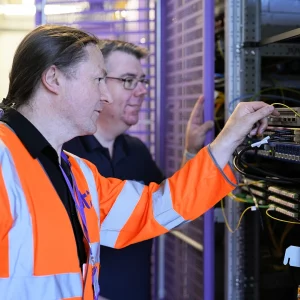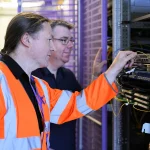Sponsored Links
UPDATE2 UK ISPs Respond to IPv4 Internet Address Depletion and IPv6 Concerns
Posted: 03rd Feb, 2011 By: MarkJ

 The Internet Assigned Numbers Authority (IANA) recently allocated its remaining normal blocks of IPv4 internet addresses to APNIC in Asia. Now all that's left is for the last blocks to be simultaneously distributed to the five Regional Internet Registries (RIRs); a date for that is expected to be set today (
The Internet Assigned Numbers Authority (IANA) recently allocated its remaining normal blocks of IPv4 internet addresses to APNIC in Asia. Now all that's left is for the last blocks to be simultaneously distributed to the five Regional Internet Registries (RIRs); a date for that is expected to be set today (Today's forthcoming announcement is effectively the last nail in IPv4's proverbial coffin, although it will admittedly take a couple more years before ISPs around the world have completely depleted the RIRs remaining addresses.
Suffice to say that the situation has caused a great deal of media confusion, not to mention some completely inaccurate reports, about what this event could mean for the internet. We explored some of the concerns in Mondays news (D-Day - Last Remaining Normal ipv4 Internet Address Blocks Finally Allocated).
One of the biggest concerns stemmed from a lack of IPv6 support by some of the UK's leading broadband ISPs. Providers that cannot support IPv4's replacement could have trouble adding new customers in the future and may even face connectivity or performance problems. Thankfully most have since told us that resolving this difficulty is a priority.
Nicholas Lansman, ISPA UK Secretary General, said:
"Some members are already offering IPv6 and other members are in the process of getting IPv6 ready. The problem for ISPs has been that the home router manufactures are only just getting to the point where they have something that supports both IPv4 and IPv6.
There is enough regional address space in the short term, however consumers should ensure that when they are updating their software or changing their contracts that it is IPv6 compatible."
"Some members are already offering IPv6 and other members are in the process of getting IPv6 ready. The problem for ISPs has been that the home router manufactures are only just getting to the point where they have something that supports both IPv4 and IPv6.
There is enough regional address space in the short term, however consumers should ensure that when they are updating their software or changing their contracts that it is IPv6 compatible."
A BT Spokesperson told ISPreview.co.uk:
"BT has been planning for the introduction of Internet Protocol Version 6 (IPv6) for some time now. We already have a large IPv6 address block allocated to it and are planning to enable the network with IPv6 capability during 2011/2012, subject to our customers' requirements.
We foresee a predictable steady demand rather than a rush. Current predictions are for IPv4 addresses to run out circa 2012. After that we'll see a steady growth in usage of IPv6. At worse it will match the current usage trends of IPv4 growth. We believe that it will start lower than that as ISPs like BT use "carrier grade Network Address Translation" to delay the need to use IPv6.
BT's 21cn equipment is IPv6 ready. We just need to turn it on when the time is right; that is when there is clear customer demand and it is commercially viable. We have also run several IPv6 trials on several of our networks for extended periods."
"BT has been planning for the introduction of Internet Protocol Version 6 (IPv6) for some time now. We already have a large IPv6 address block allocated to it and are planning to enable the network with IPv6 capability during 2011/2012, subject to our customers' requirements.
We foresee a predictable steady demand rather than a rush. Current predictions are for IPv4 addresses to run out circa 2012. After that we'll see a steady growth in usage of IPv6. At worse it will match the current usage trends of IPv4 growth. We believe that it will start lower than that as ISPs like BT use "carrier grade Network Address Translation" to delay the need to use IPv6.
BT's 21cn equipment is IPv6 ready. We just need to turn it on when the time is right; that is when there is clear customer demand and it is commercially viable. We have also run several IPv6 trials on several of our networks for extended periods."
Head of Marketing at Entanet UK, Darren Farnden, added:
"It's true that it'll be a long time before the use of IPv4 addresses comes to an end. It's also true that IPv6 is going to be around for a lot longer - after all, each subnet has 18,446,744,073,709,551,616 addresses! It's also true that any sensible ISP will dual stack IPv4 and IPv6 addresses (Entanet already allows customers to have IPv6 subnets).
However, unless certain things change, it'll be when ISPs completely run out of available IPv4 addresses that the problems may start. Many ISPs still have available IPv4 addresses that they're probably managing as carefully as possible. As these run thin though, we're likely to see them only being able to provide IPv4 addresses that are "NAT'd" and this could create issues with IP services, such as VoIP and VPN for example.
Among the CPE currently on the market, some models are at best partially IPv6 compatible and so we encourage vendors to release firmware updates on at least their current models."
"It's true that it'll be a long time before the use of IPv4 addresses comes to an end. It's also true that IPv6 is going to be around for a lot longer - after all, each subnet has 18,446,744,073,709,551,616 addresses! It's also true that any sensible ISP will dual stack IPv4 and IPv6 addresses (Entanet already allows customers to have IPv6 subnets).
However, unless certain things change, it'll be when ISPs completely run out of available IPv4 addresses that the problems may start. Many ISPs still have available IPv4 addresses that they're probably managing as carefully as possible. As these run thin though, we're likely to see them only being able to provide IPv4 addresses that are "NAT'd" and this could create issues with IP services, such as VoIP and VPN for example.
Among the CPE currently on the market, some models are at best partially IPv6 compatible and so we encourage vendors to release firmware updates on at least their current models."
Sadly many ISPs, especially larger providers, were unwilling to talk with us about the situation. We weren't surprised by that, especially when most will only privately admit to having no near term IPv6 support prepared. Part of the reason for this is alluded to in several of the ISP comments (above).
The biggest problem for most consumer facing broadband providers is a lack of affordable, IPv6 supporting end-user (customer) connection hardware (routers, modems etc.). Most ISPs claim that there are virtually no low-cost IPv6 supporting consumer routers available and the manufacturers are only just waking up to the problem. Meanwhile others, such as Virgin Media UK, have support for IPv6 in their newest (D3) cable routers but not the old ones.
In fairness this is partly because too few of the largest ISPs, some of which have plenty of spare IPv4 addresses (enough to last them for a good few years), have as a result not been bold enough in requesting IPv6 support from the manufacturers. There's much more choice at the business end.
Ultimately no competent ISP would want to put itself into in a position where the addition of new customers is not possible. Neither would any credible ISP allow addition of new users to only be viable through half-way measures like IPv4 address sharing, which carries with it all sorts of connectivity and performance problems.
Never the less, IPv4's final address block allocation is the signal for all ISPs to get themselves prepared for an inevitable future. It's costly to run dual stack IPv4 and IPv6 networks side by side and eventually they'll want to get rid of IPv4 altogether, but that won't happen for quite a few years yet (it would cause far too many problems with older software and devices).
In the meantime consumers probably don't need to worry. The transition from IPv4 to v6 should be fairly seamless and with any luck you won't notice it happening at all.
UPDATE 3:28pm
IANA has just officially handed over the last remaining blocks (102, 103, 104, 179 and 185) of IPv4 internet addresses to the five regional registries.
Raúl EcheberrÃa, Chairman of the Number Resource Organization (NRO), said:
"Each RIR will have its final full /8 from IANA, plus any existing IP address holdings to distribute. Depending on address space requests received, this could last each RIR anywhere from a few weeks to many months. It’s only a matter of time before the RIRs and Internet Service Providers (ISPs) must start denying requests for IPv4 address space. Deploying IPv6 is now a requirement, not an option."
"Each RIR will have its final full /8 from IANA, plus any existing IP address holdings to distribute. Depending on address space requests received, this could last each RIR anywhere from a few weeks to many months. It’s only a matter of time before the RIRs and Internet Service Providers (ISPs) must start denying requests for IPv4 address space. Deploying IPv6 is now a requirement, not an option."
Six months is possible but markets do vary and some estimates say up to two years. Either way, it's good to be prepared.
Search ISP News
Search ISP Listings
Search ISP Reviews
Latest UK ISP News








Cheap BIG ISPs for 100Mbps+
150,000+ Customers | View More ISPs
Cheapest ISPs for 100Mbps+
Modest Availability | View More ISPs
Latest UK ISP News
Helpful ISP Guides and Tips
Sponsored Links
The Top 15 Category Tags
- FTTP (6830)
- BT (3894)
- Politics (3086)
- Business (2778)
- Openreach (2672)
- Building Digital UK (2519)
- Mobile Broadband (2490)
- FTTC (2144)
- Statistics (2138)
- 4G (2106)
- Virgin Media (2034)
- Ofcom Regulation (1785)
- 5G (1748)
- Fibre Optic (1607)
- Wireless Internet (1601)
Sponsored
Copyright © 1999 to Present - ISPreview.co.uk - All Rights Reserved - Terms , Privacy and Cookie Policy , Links , Website Rules































